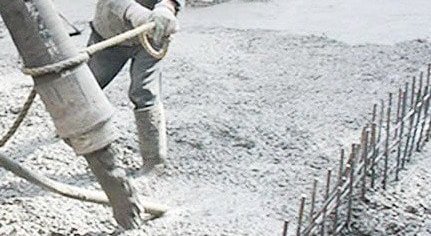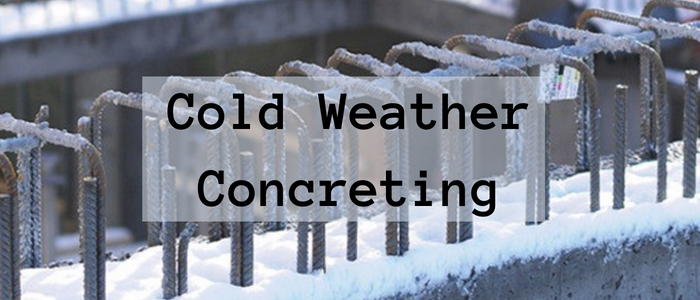What is cold weather concreting?
Cold weather concreting (pouring concrete in cold weather) is one of the most challenging problems that face concrete practitioners in cold regions such as North America and other cold areas.
Cold weather concreting refers to doing the construction activities in cold weather. These construction activities include placement, finishing, curing, and protection of concrete.

What is cold weather?
So, here comes the question, when can we say this is a cold weather? The answer according to ACI (The American Concrete Institute” as follows:
“a period when the average daily ambient temperature is below (or expected to fall below) 40°F (5°C) for more than 3 successive days”
Here, we are speaking about the average temperature, which is the average of the maximum and minimum temperatures during a day measured from mid-night to mid-night.
This means if temperature went above 10°C for more than 12 hours (half a day), we are not in cold weather.
What are the problems of cold weather concreting?
Problems associated with cold weather concreting are:
- Freezing of concrete at an early age
- Lack of the required strength
- Improper curing procedures
- Fast temperature changes
- Inadequate protection of the structure consistent with its serviceability
- Stop in construction most of the wintertime which has a significant economic and social impact.
You may know that normal concrete in normal weather sets (hardens) after about 6 hours of casting. When concrete is placed in cold weather, the setting time increases significantly, and it may not even set.
For example, if the temperature of the weather makes the temperature of concrete 4.4°C, the setting time increases to 14 hours instead of six hours, which is considered a very long time.
Imagine what happens if the temperature of the concrete drops below 4.4°C?
Concrete in this case freezes and doesn’t set properly; it loses up to 50% of its strength, and of course a significant increase in the permeability of concrete.
In addition, the water inside the concrete pores experiences increase in volume by 9 percent when it converts to ice. This increase in volume causes internal stresses on the cement paste, resulting in the reduction of concrete compressive strength by very significant amounts can reach up to 70%.
Research has shown that the hydration process of concrete theoretically stops below a temperature of -2.8°C because the mixing water freezes inside the concrete and of course it will not be available for reactions.
Problems related cold weather concreting doesn’t happen in the temperature of the concrete at its fresh state is maintained above 10°C, so if we could keep the temperature above this level during the protection period that is needed for concrete to get its mechanical and physical properties, we will not face any problems with the setting of concrete.
4 Mistakes when dealing with cold weather concreting
There are many mistakes that can happen by concrete workers during working with concrete in cold weather such as the following:
1. Allowing concrete to freeze
We need to maintain the temperature of concrete above 10°C until, as ACI states, the concrete reaches its expected strength. If concrete froze before reaching a strength of 3.5 MPa, it will never reach its expected compressive strength. The external layer of concrete should follow a mixture design resistant to freezing-thaw cycles such as air-entraining concrete mixtures and also, it should have enough strength before the exposure to the cycles.
2. Casting concrete on frozen ground
A common mistake with casting concrete in cold weather is placing on frozen grounds.
What happens in this case? Once ground thaws (may be in summer or on another nice day in winter), it experiences settlement which causes cracks in concrete.
Another issue is related to hardening of concrete; the face in contact with the ground will harden more slowly. This difference in hardening level between the top and bottom faces can cause cracking or crusting.
3. Inaccurate temperature of concrete before casting
Concrete should have a certain initial temperature before it reaches the construction site to have a proper temperature before casting.
4. Removing heating systems quickly
Removing the systems used for heating and hoarding too quickly after curing cause a sudden thermal shock to concrete and rapid cools which causes cracking to concrete.
Mixture Design for Cold Weather Concrete
Of course, there will be differences between the mixture design of concrete serving in normal weather and concrete serving in cold weather. Some difference points are:
1. Cement Type
Usually, cold weather concrete uses high-early strength cement since it has higher fineness and hydrates faster giving high early strength.
2. Higher cement content
Cold weather concrete has higher cement content (approximately 50 kg/m3).
3. Less cement replacement materials
Supplementary Cementitious Materials are used less frequently in cold weather concrete because some of them such as fly ash may increase the setting time and delays the strength development.
4. Admixtures
Cold weather concrete uses more admixtures compared to normal concrete. It usually uses what is called “cold weather admixture system” to accelerate the setting of concrete and decrease the freezing point of water.
Precautions for Cold Weather Concrete
Keep the following points in mind when dealing with the cold weather concreting:
Preventing freezing of concrete at early ages to ensure appropriate strength development and reducing the potential of concrete for thermal cracking. To prevent the freezing of concrete, do the following:
- Heat concrete ingredients like water and aggregates before mixing in concrete.
- Use heated enclosures to provide appropriate temperature for concrete to set and cure.
- Use higher cement content or Type III cement.
- Employ protective insulations.
Read Also:
